June 23, 2016 at 2:32 pm
[caption id="attachment_1603" align="alignright" width="455"]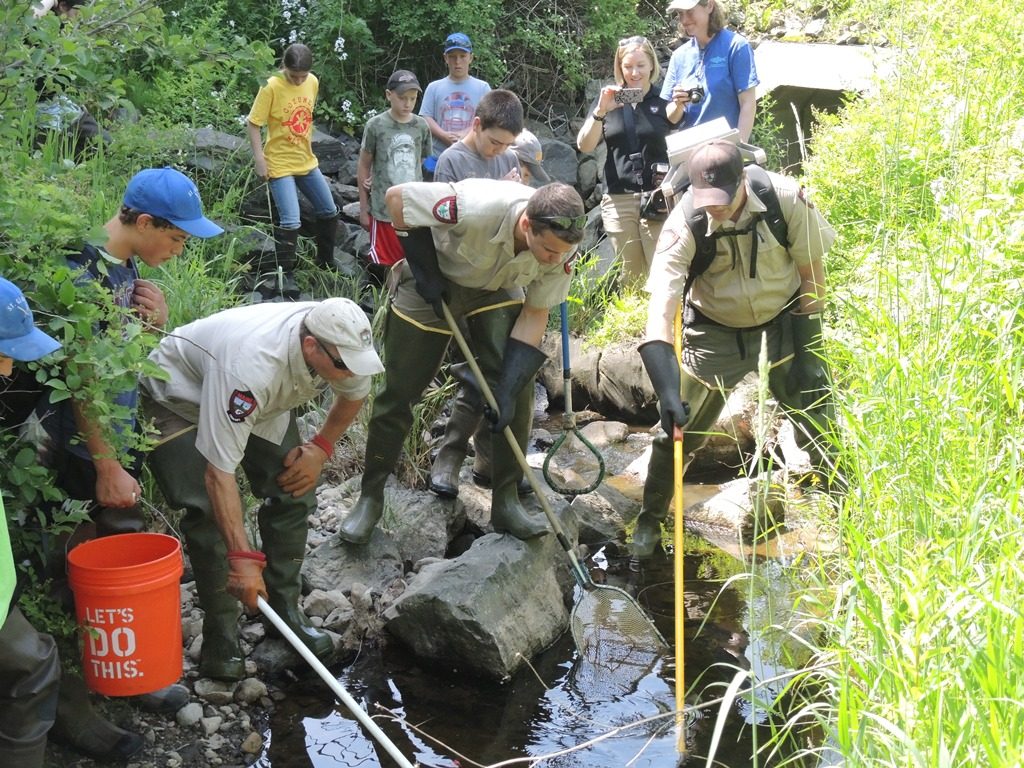 IFW fisheries biologists electrofish a small coastal stream looking for brook trout. Students from the St. George School Summer Science Camp and members of Merrymeeting TU also helped out.[/caption]
Salters, or sear run brook trout, possess a certain mystique. Brook trout are most closely associated with cool, mountain streams, but as many avid brook trout anglers know, you can find them throughout Maine in streams that remain cool in the summer.
Brook trout thrive in cold water, and in order to survive, they need water that generally stays below 65-70 degrees. Many small streams in Maine possess that habitat, and some of these small streams lead into the ocean or estuaries.
Some of the brook trout that live in these ocean-side streams travel in and out of the stream into the ocean. How long they stay varies. Sometimes it may just be for a tide cycle, or it may be a few weeks or longer.
Reasons vary for these forays into the ocean, but most believe that a combination of looking for food, or seeking thermal refuge in a cooler ocean from a rapidly warming stream.
[caption id="attachment_1607" align="alignleft" width="463"]
IFW fisheries biologists electrofish a small coastal stream looking for brook trout. Students from the St. George School Summer Science Camp and members of Merrymeeting TU also helped out.[/caption]
Salters, or sear run brook trout, possess a certain mystique. Brook trout are most closely associated with cool, mountain streams, but as many avid brook trout anglers know, you can find them throughout Maine in streams that remain cool in the summer.
Brook trout thrive in cold water, and in order to survive, they need water that generally stays below 65-70 degrees. Many small streams in Maine possess that habitat, and some of these small streams lead into the ocean or estuaries.
Some of the brook trout that live in these ocean-side streams travel in and out of the stream into the ocean. How long they stay varies. Sometimes it may just be for a tide cycle, or it may be a few weeks or longer.
Reasons vary for these forays into the ocean, but most believe that a combination of looking for food, or seeking thermal refuge in a cooler ocean from a rapidly warming stream.
[caption id="attachment_1607" align="alignleft" width="463"]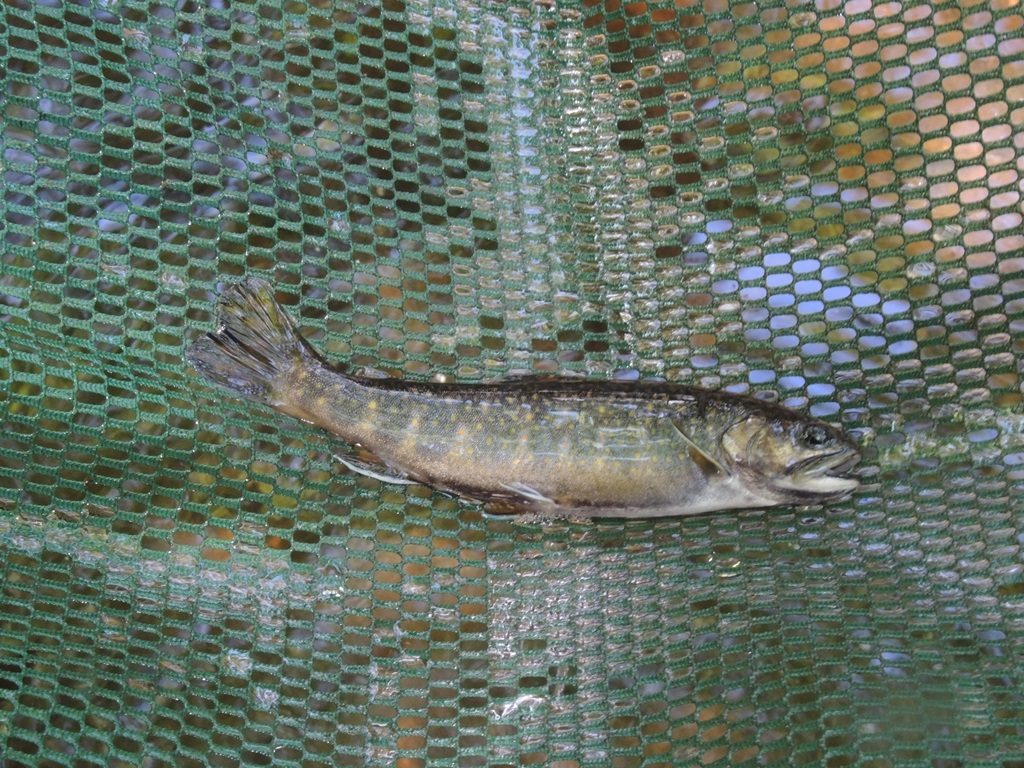 A typical brook trout from a coastal stream. This one was about four inches in length.[/caption]
They return once they finish feeding, or to escape predators such as striped bass or avian ones such as osprey and eagles.
In some coastal streams, you will have both salters and brook trout. Salters have a silver sheen to them that differentiate them from their freshwater-only brethren, and they grow faster than those that stay in the small freshwater stream since they feed on more abundant food in the ocean. It is not unusual to have brook trout that are the same age, but the salters are significantly bigger.
IFW continues to research the range and habits of salters. Currently, the Department, along with Maine Audubon, Trout Unlimited and a number of volunteers are surveying coastal streams to determine which streams have trout populations and which do not.
[caption id="attachment_1606" align="aligncenter" width="728"]
A typical brook trout from a coastal stream. This one was about four inches in length.[/caption]
They return once they finish feeding, or to escape predators such as striped bass or avian ones such as osprey and eagles.
In some coastal streams, you will have both salters and brook trout. Salters have a silver sheen to them that differentiate them from their freshwater-only brethren, and they grow faster than those that stay in the small freshwater stream since they feed on more abundant food in the ocean. It is not unusual to have brook trout that are the same age, but the salters are significantly bigger.
IFW continues to research the range and habits of salters. Currently, the Department, along with Maine Audubon, Trout Unlimited and a number of volunteers are surveying coastal streams to determine which streams have trout populations and which do not.
[caption id="attachment_1606" align="aligncenter" width="728"]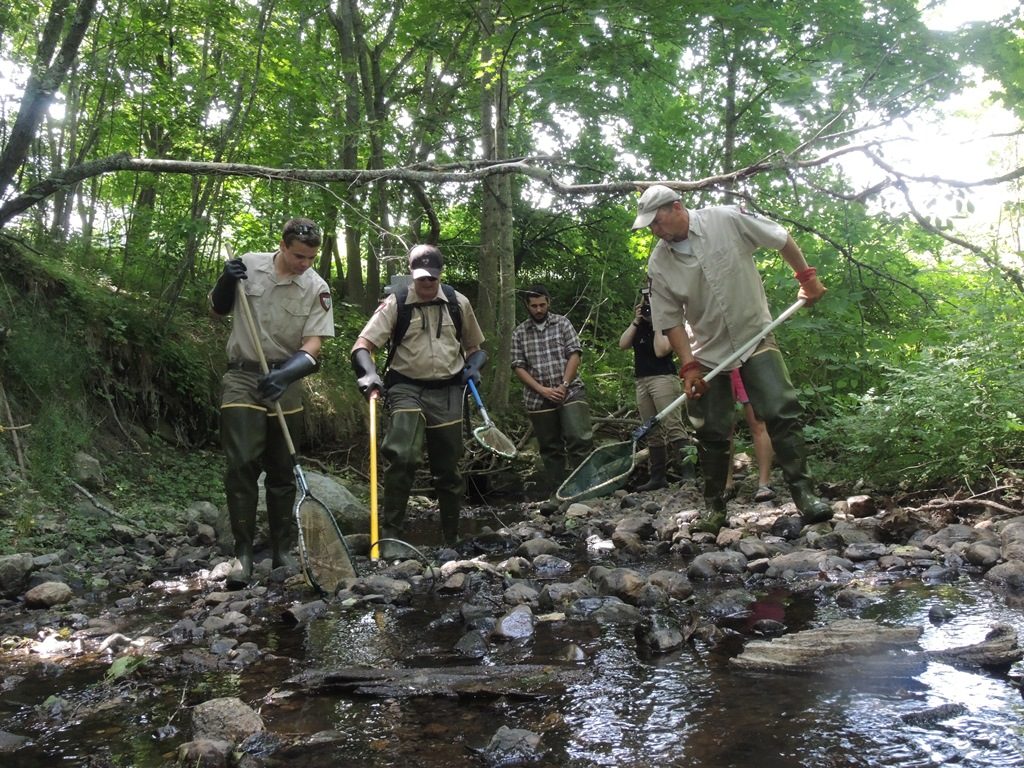 The yellow wand sends an electrical current into the water that momentarily stuns fish. The fish are scooped up by the nets, measured, and released.[/caption]
In Waldoboro, a UMaine – Fort Kent student, along with IFW fisheries staff from our Region B office, is documenting how brook trout utilize the stream and tributaries. By capturing trout with electrofishing equipment, marking them with a unique fin clip, and then releasing them, biologists can track them by electrofishing the stream each month, and see if these fish stay put in the same tributary, or if they move throughout the stream’s watershed.
[caption id="attachment_1605" align="alignright" width="435"]
The yellow wand sends an electrical current into the water that momentarily stuns fish. The fish are scooped up by the nets, measured, and released.[/caption]
In Waldoboro, a UMaine – Fort Kent student, along with IFW fisheries staff from our Region B office, is documenting how brook trout utilize the stream and tributaries. By capturing trout with electrofishing equipment, marking them with a unique fin clip, and then releasing them, biologists can track them by electrofishing the stream each month, and see if these fish stay put in the same tributary, or if they move throughout the stream’s watershed.
[caption id="attachment_1605" align="alignright" width="435"]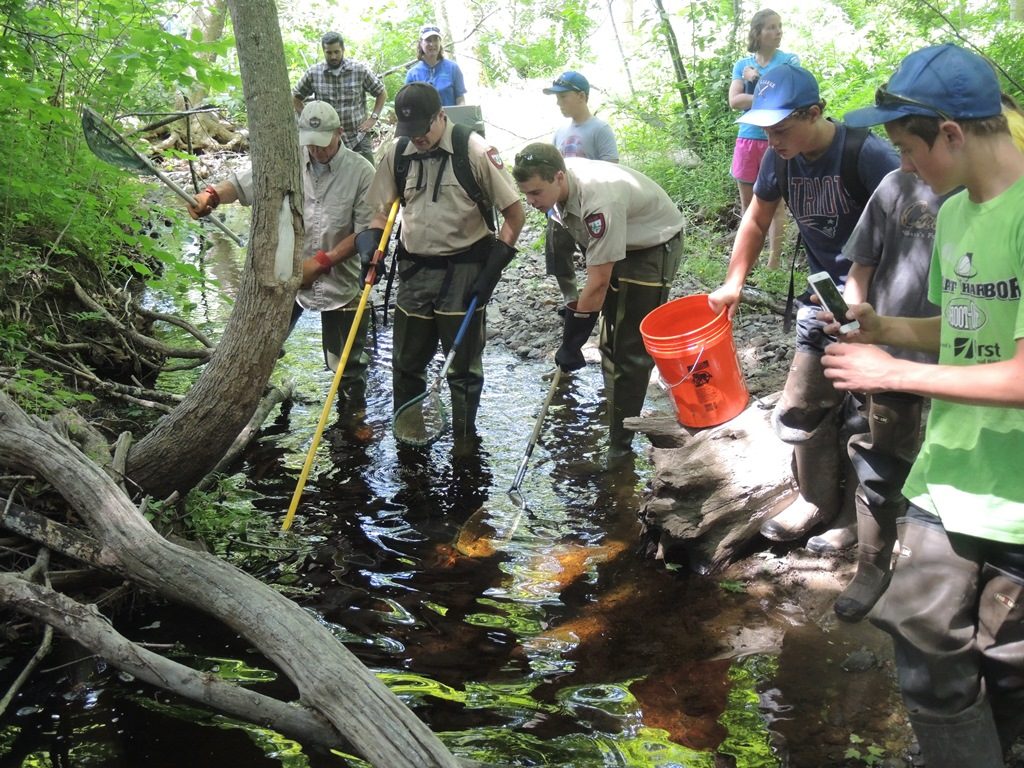 This shaded stream provides ideal habitat for brook trout. Deep undercut banks like this also protect trout from predators.[/caption]
On Tuesday, Umaine Fort Kent Student Kyle Blake, IFW fisheries biologist Jason Seiders, IFW creel clerks Tom Barrows and Camden Marshall, were joined by the St. George School Summer Science Camp and members of the Merrymeeting Bay chapter of Trout Unlimited, to capture brook trout.
The crew captured dozens of brook trout, ranging in size from just a couple of inches, to several that were over 8 inches. Seiders thought there were five different year classes of trout; from fish that were just born this year, to fish that were approaching five years old.
This was the second time this summer that the crew electrofished the stream. The plan is to electrofish the stream each month to document movement. Interestingly, in just four weeks, they are seeing movement by the trout from one tributary to another in the watershed. Time will tell how often they move.
[caption id="attachment_1608" align="alignright" width="331"]
This shaded stream provides ideal habitat for brook trout. Deep undercut banks like this also protect trout from predators.[/caption]
On Tuesday, Umaine Fort Kent Student Kyle Blake, IFW fisheries biologist Jason Seiders, IFW creel clerks Tom Barrows and Camden Marshall, were joined by the St. George School Summer Science Camp and members of the Merrymeeting Bay chapter of Trout Unlimited, to capture brook trout.
The crew captured dozens of brook trout, ranging in size from just a couple of inches, to several that were over 8 inches. Seiders thought there were five different year classes of trout; from fish that were just born this year, to fish that were approaching five years old.
This was the second time this summer that the crew electrofished the stream. The plan is to electrofish the stream each month to document movement. Interestingly, in just four weeks, they are seeing movement by the trout from one tributary to another in the watershed. Time will tell how often they move.
[caption id="attachment_1608" align="alignright" width="331"]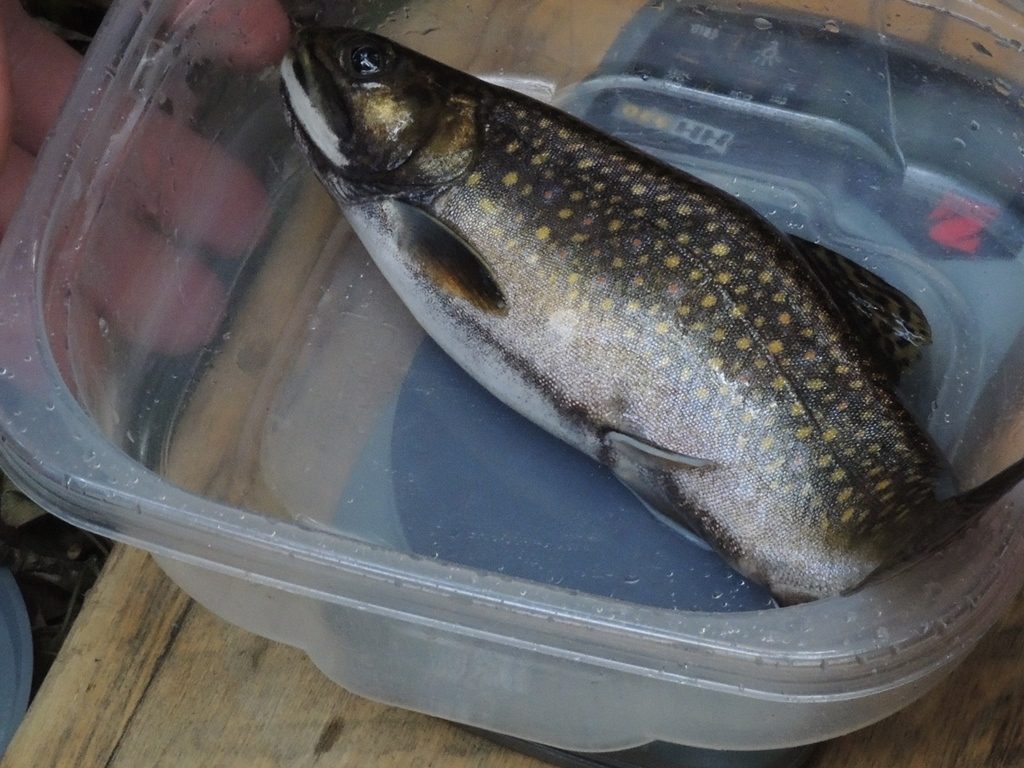 A plump brook trout is weighed.[/caption]
The data collected will be the centerpiece of UMFK’s Kyle Blake’s senior capstone project, and what is learned will be utilized to help manage and protect brook trout populations that inhabit small coastal streams.
[caption id="attachment_1610" align="alignleft" width="297"]
A plump brook trout is weighed.[/caption]
The data collected will be the centerpiece of UMFK’s Kyle Blake’s senior capstone project, and what is learned will be utilized to help manage and protect brook trout populations that inhabit small coastal streams.
[caption id="attachment_1610" align="alignleft" width="297"]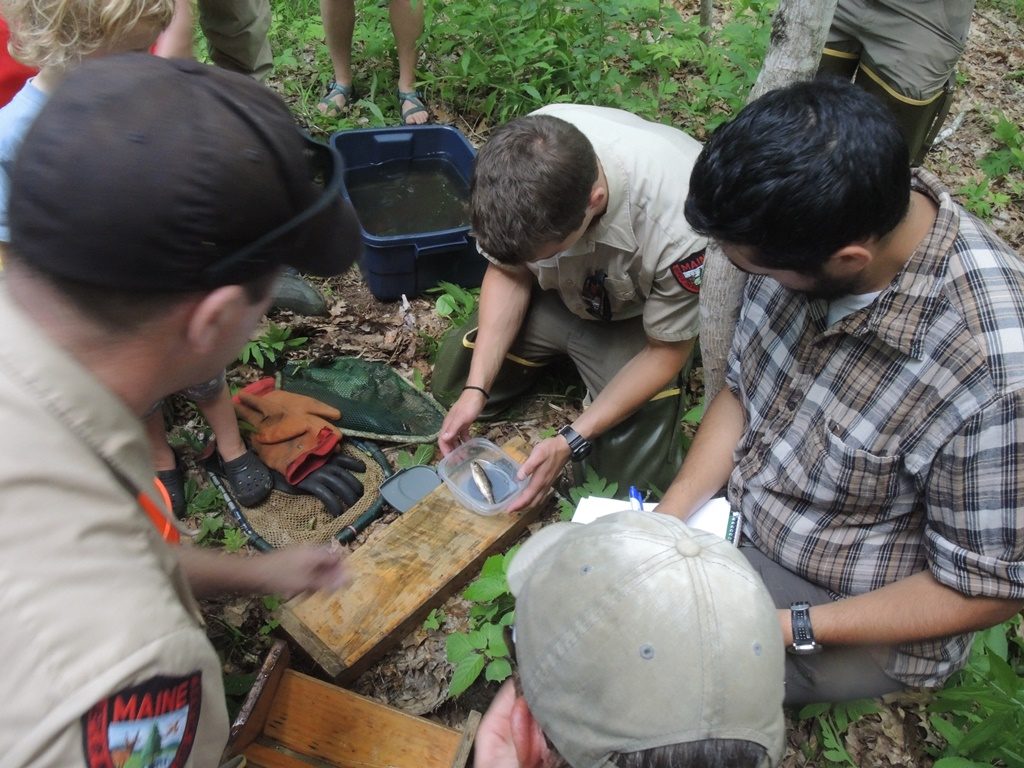 Each trout is measured and weighed, and the biological data is recorded. Each fish also has a fin clipped, which allows biologists to track the trout through the watershed.[/caption]
Each trout is measured and weighed, and the biological data is recorded. Each fish also has a fin clipped, which allows biologists to track the trout through the watershed.[/caption]
 IFW fisheries biologists electrofish a small coastal stream looking for brook trout. Students from the St. George School Summer Science Camp and members of Merrymeeting TU also helped out.[/caption]
Salters, or sear run brook trout, possess a certain mystique. Brook trout are most closely associated with cool, mountain streams, but as many avid brook trout anglers know, you can find them throughout Maine in streams that remain cool in the summer.
Brook trout thrive in cold water, and in order to survive, they need water that generally stays below 65-70 degrees. Many small streams in Maine possess that habitat, and some of these small streams lead into the ocean or estuaries.
Some of the brook trout that live in these ocean-side streams travel in and out of the stream into the ocean. How long they stay varies. Sometimes it may just be for a tide cycle, or it may be a few weeks or longer.
Reasons vary for these forays into the ocean, but most believe that a combination of looking for food, or seeking thermal refuge in a cooler ocean from a rapidly warming stream.
[caption id="attachment_1607" align="alignleft" width="463"]
IFW fisheries biologists electrofish a small coastal stream looking for brook trout. Students from the St. George School Summer Science Camp and members of Merrymeeting TU also helped out.[/caption]
Salters, or sear run brook trout, possess a certain mystique. Brook trout are most closely associated with cool, mountain streams, but as many avid brook trout anglers know, you can find them throughout Maine in streams that remain cool in the summer.
Brook trout thrive in cold water, and in order to survive, they need water that generally stays below 65-70 degrees. Many small streams in Maine possess that habitat, and some of these small streams lead into the ocean or estuaries.
Some of the brook trout that live in these ocean-side streams travel in and out of the stream into the ocean. How long they stay varies. Sometimes it may just be for a tide cycle, or it may be a few weeks or longer.
Reasons vary for these forays into the ocean, but most believe that a combination of looking for food, or seeking thermal refuge in a cooler ocean from a rapidly warming stream.
[caption id="attachment_1607" align="alignleft" width="463"] A typical brook trout from a coastal stream. This one was about four inches in length.[/caption]
They return once they finish feeding, or to escape predators such as striped bass or avian ones such as osprey and eagles.
In some coastal streams, you will have both salters and brook trout. Salters have a silver sheen to them that differentiate them from their freshwater-only brethren, and they grow faster than those that stay in the small freshwater stream since they feed on more abundant food in the ocean. It is not unusual to have brook trout that are the same age, but the salters are significantly bigger.
IFW continues to research the range and habits of salters. Currently, the Department, along with Maine Audubon, Trout Unlimited and a number of volunteers are surveying coastal streams to determine which streams have trout populations and which do not.
[caption id="attachment_1606" align="aligncenter" width="728"]
A typical brook trout from a coastal stream. This one was about four inches in length.[/caption]
They return once they finish feeding, or to escape predators such as striped bass or avian ones such as osprey and eagles.
In some coastal streams, you will have both salters and brook trout. Salters have a silver sheen to them that differentiate them from their freshwater-only brethren, and they grow faster than those that stay in the small freshwater stream since they feed on more abundant food in the ocean. It is not unusual to have brook trout that are the same age, but the salters are significantly bigger.
IFW continues to research the range and habits of salters. Currently, the Department, along with Maine Audubon, Trout Unlimited and a number of volunteers are surveying coastal streams to determine which streams have trout populations and which do not.
[caption id="attachment_1606" align="aligncenter" width="728"] The yellow wand sends an electrical current into the water that momentarily stuns fish. The fish are scooped up by the nets, measured, and released.[/caption]
In Waldoboro, a UMaine – Fort Kent student, along with IFW fisheries staff from our Region B office, is documenting how brook trout utilize the stream and tributaries. By capturing trout with electrofishing equipment, marking them with a unique fin clip, and then releasing them, biologists can track them by electrofishing the stream each month, and see if these fish stay put in the same tributary, or if they move throughout the stream’s watershed.
[caption id="attachment_1605" align="alignright" width="435"]
The yellow wand sends an electrical current into the water that momentarily stuns fish. The fish are scooped up by the nets, measured, and released.[/caption]
In Waldoboro, a UMaine – Fort Kent student, along with IFW fisheries staff from our Region B office, is documenting how brook trout utilize the stream and tributaries. By capturing trout with electrofishing equipment, marking them with a unique fin clip, and then releasing them, biologists can track them by electrofishing the stream each month, and see if these fish stay put in the same tributary, or if they move throughout the stream’s watershed.
[caption id="attachment_1605" align="alignright" width="435"] This shaded stream provides ideal habitat for brook trout. Deep undercut banks like this also protect trout from predators.[/caption]
On Tuesday, Umaine Fort Kent Student Kyle Blake, IFW fisheries biologist Jason Seiders, IFW creel clerks Tom Barrows and Camden Marshall, were joined by the St. George School Summer Science Camp and members of the Merrymeeting Bay chapter of Trout Unlimited, to capture brook trout.
The crew captured dozens of brook trout, ranging in size from just a couple of inches, to several that were over 8 inches. Seiders thought there were five different year classes of trout; from fish that were just born this year, to fish that were approaching five years old.
This was the second time this summer that the crew electrofished the stream. The plan is to electrofish the stream each month to document movement. Interestingly, in just four weeks, they are seeing movement by the trout from one tributary to another in the watershed. Time will tell how often they move.
[caption id="attachment_1608" align="alignright" width="331"]
This shaded stream provides ideal habitat for brook trout. Deep undercut banks like this also protect trout from predators.[/caption]
On Tuesday, Umaine Fort Kent Student Kyle Blake, IFW fisheries biologist Jason Seiders, IFW creel clerks Tom Barrows and Camden Marshall, were joined by the St. George School Summer Science Camp and members of the Merrymeeting Bay chapter of Trout Unlimited, to capture brook trout.
The crew captured dozens of brook trout, ranging in size from just a couple of inches, to several that were over 8 inches. Seiders thought there were five different year classes of trout; from fish that were just born this year, to fish that were approaching five years old.
This was the second time this summer that the crew electrofished the stream. The plan is to electrofish the stream each month to document movement. Interestingly, in just four weeks, they are seeing movement by the trout from one tributary to another in the watershed. Time will tell how often they move.
[caption id="attachment_1608" align="alignright" width="331"] A plump brook trout is weighed.[/caption]
The data collected will be the centerpiece of UMFK’s Kyle Blake’s senior capstone project, and what is learned will be utilized to help manage and protect brook trout populations that inhabit small coastal streams.
[caption id="attachment_1610" align="alignleft" width="297"]
A plump brook trout is weighed.[/caption]
The data collected will be the centerpiece of UMFK’s Kyle Blake’s senior capstone project, and what is learned will be utilized to help manage and protect brook trout populations that inhabit small coastal streams.
[caption id="attachment_1610" align="alignleft" width="297"] Each trout is measured and weighed, and the biological data is recorded. Each fish also has a fin clipped, which allows biologists to track the trout through the watershed.[/caption]
Each trout is measured and weighed, and the biological data is recorded. Each fish also has a fin clipped, which allows biologists to track the trout through the watershed.[/caption]
Categories